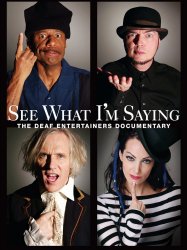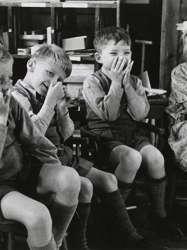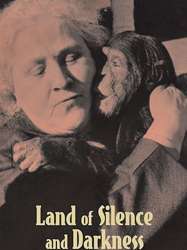See What I Say is a american film of genre Documentary released in USA on 1 january 1981 with Holly Near
See What I Say (1981)

If you like this film, let us know!
Released in USA 1 january 1981
OriginUSA
Genres Documentary
Themes Documentaire sur une personnalité, Films about disabilities, Sign-language films, American Sign Language films
Rating67%










See What I Say is a 1981 American short documentary film produced by Linda Chapman, Pam LeBlanc and Freddi Stevens. It was nominated for an Academy Award for Best Documentary Short. The subjects of the film are hearing-impaired women who discuss their use of sign language.
Actors

Holly Near
(Herself)
Comments
Leave comment :
Suggestions of similar film to See What I Say
There are 2 films with the same actors, 8968 with the same cinematographic genres, 3373 films with the same themes (including 3 films with the same 4 themes than See What I Say), to have finally 70 suggestions of similar films.If you liked See What I Say, you will probably like those similar films :
 , 1h31
, 1h31Origin USA
Genres Documentary
Themes Medical-themed films, Documentaire sur une personnalité, Films about disabilities, Personne sourde ou muette, Sign-language films, American Sign Language films, Films about language and translation
Actors Bob Hiltermann, CJ Jones, Shoshannah Stern, TL Forsberg, Tyrone Giordano, Troy Kotsur
Rating69%





Ce film documentaire suit les traces des artistes sourds les plus populaires dans le monde des sourds américains comme le batteur Bob Hiltermann (du groupe rock Beethoven's Nightmare), la chanteuse TL Forsberg, l'humoriste CJ Jones et l'acteur Robert DeMayo.

Sound and Fury (2000)
, 1h20Origin USA
Genres Documentary
Themes Films about children, Films about families, Documentaire sur une personnalité, Films about disabilities, Sign-language films, American Sign Language films
Rating77%





The film follows the Artinian extended family with deafness through three generations over a year and a half, focusing on two brothers — Peter Artinian, who is deaf and Chris Artinian, who has proficient hearing — and their wives and children. Chris and Mari Artinian (who is a Child of Deaf Adult) find out that one of their newborn twins is deaf. They begin to research the cochlear implant and its advantages and disadvantages.. While this is going on, Heather, Peter and Nita's oldest child, starts asking for an implant as well. The brothers, along with grandparents on both sides, become embroiled in a bitter argument over the importance of deafness, the best form of education for their kids, and the controversy of cochlear implants for young children. For Peter and his wife, Nita, it's their fear of losing a child to the "hearing world", and her losing the importance of Deaf culture, which concerns them.

The Unconquered (1954)
, 55minutesOrigin USA
Genres Documentary
Themes Medical-themed films, Documentaire sur une personnalité, Films about disabilities, Sign-language films, American Sign Language films, Films about language and translation
Actors Katharine Cornell
Rating70%





Helen Keller is a blind and a deaf girl. The film shows how she struggles with her life..

In the Land of the Deaf (1992)
, 1h39Directed by Nicolas Philibert
Origin France
Genres Documentary
Themes Medical-themed films, Documentaire sur une personnalité, Films about disabilities, Personne sourde ou muette, Sign-language films, French Sign Language films, Films about language and translation
Actors Claire Garguier, Levent Beskardes, Chantal Liennel
Rating75%





This film focuses on the interrelationships between Deaf culture and language in France. Its overview encompasses a broad range of perspectives, contrasting the stories of a family who has been deaf and thriving for five generations with the story of a woman whose deafness was misunderstood, causing her to be confined for a time in an asylum for the insane. The documentary features hearing-impaired people of all ages and from all walks of life. With their profound deafness in common, the children and adults featured in this film communicate their dreams and thoughts through sign language. In one segment, Philibert focuses his camera on group of schoolchildren who are learning how to communicate in a world where they must read lips and speak words. The personal lives of some of the pupils and various adults are explored, including an actor, a sign-language teacher, and an engaged couple.

Thursday's Children (1954)
, 21minutesDirected by Lindsay Anderson
Origin United-kingdom
Genres Documentary
Themes Films about education, Films about children, Documentaire sur une personnalité, Films about disabilities, Sign-language films
Actors Richard Burton
Rating72%





Tourné dans l'école pour enfants sourds de Margate dans le Kent en Angleterre, le film s'intéresse aux visages et aux gestes de petits garçons et petites filles. L'école apprend la lecture sur les lèvres plutôt que la langue des signes, et le film note que seulement un enfant sur trois finit par acquérir un véritable langage parlé.

Wedding of Silence (2003)
Genres Documentary
Themes Documentaire sur une personnalité, Films about disabilities, Sign-language films

Koko: A Talking Gorilla (1978)
, 1h25Directed by Barbet Schroeder
Origin France
Genres Documentary
Themes Films about animals, Environmental films, Medical-themed films, Documentaire animalier, Documentary films about environmental issues, Films about apes, Films about disabilities, Documentary films about nature, Mise en scène d'un mammifère, Sign-language films, American Sign Language films, Films about language and translation
Rating72%





The film introduces us to Koko soon after she was brought from the San Francisco Zoo to Stanford University by Dr. Penny Patterson for a controversial experiment—she would be taught the basics of human communication through American Sign Language.

Land of Silence and Darkness (1971)
, 1h25Directed by Werner Herzog
Origin German
Genres Documentary
Themes Medical-themed films, Documentaire sur une personnalité, Films about disabilities, La cécité, Personne sourde ou muette, Sign-language films, Films about language and translation
Actors Werner Herzog
Rating78%





Un regard sur Fini Straubinger, une vieille dame sourde et aveugle depuis son adolescence, et sur son travail en compagnie d'autres personnes sourdaveugles. Le film montre comment ils éprouvent des difficultés à comprendre et accepter une communauté dans laquelle ils sont quasiment isolés.

Laughology (2009)
, 1h5Directed by Albert Nerenberg
Origin Canada
Genres Documentary
Themes Medical-themed films, Documentaire sur une personnalité, Documentary films about health care, Films about psychiatry, Films about disabilities
Rating68%





Laughology tells the story of how Nerenberg became a Laughologist following a family tragedy and reveals new information about the nature of laughter. Nerenberg travels from Canada to the United States, India, London, and Tanzania in search of his laugh. Some of the elements of the film were chronicled in Nerenberg’s popular series in the Montreal Gazette on Positivity. The film also claims to have found the man with the world's most contagious laugh, Doug Collins. In the film, Collins travels with Nerenberg to London England where the science behind his laugh is tested by the neuroscientific team responsible for proving that laughter is contagious.

Passion Despair (2011)
, 1h33Genres Documentary
Themes Films about children, Medical-themed films, Films about sexuality, Films about pedophilia, Documentary films about the visual arts, Documentary films about law, Documentaire sur une personnalité, Documentary films about health care, Documentary films about child abuse, Films about psychiatry, Films about disabilities, Films about child abuse
 Connection
Connection